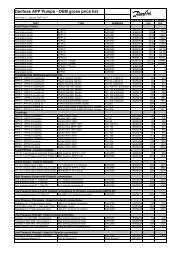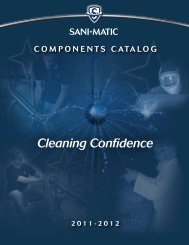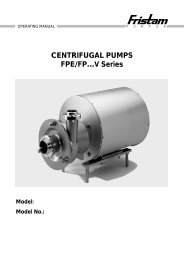data sheet
data sheet
data sheet
Create successful ePaper yourself
Turn your PDF publications into a flip-book with our unique Google optimized e-Paper software.
6. Inlet pressure<br />
Water supply to the pump is either made from a tank placed above the pump or directly from a feed pump. The pressure at the<br />
pump inlet (I) must be in the range: 0.5 - 5 bar (7.3 - 72.5 psi).<br />
7. Temperature and corrosion<br />
7.1 Operation:<br />
• Fluid temperature: +3°C to +50°C (+37.4°F to 122°F) - dependent on the NaCl concentration<br />
• Ambient temperature: +3°C to +50°C (+37.4°F to 122°F)<br />
The chart below illustrates the corrosive resistance of different types of stainless steel related to NaCl concentration and<br />
temperature.<br />
All critical parts of the APP water pump is made of SAF 2507.<br />
If the water pump is operated at high salinity, always flush the water pump with fresh water at operation stop in order to minimise<br />
the risk of crevice corrosion.<br />
904L / SAF 2205<br />
NaCl vs. temperature<br />
7.2 Storage:<br />
• Storage temperature: -40°C to +70°C (+37.4°F to 122°F) – provided that the pump is drained of fluid and stored<br />
”plugged”.<br />
Antefreeze protection is required at temperatures below 2°C. Danfoss recommends using Dowcal N from Dow Chemical<br />
Company or Chillsafe mono propylene glycol from Arco Chemical Company.<br />
8. Noise level<br />
The chart indicates the noise level in dB(A) measured at a distance of 1 m from the pump in a reverberation room.<br />
Type<br />
60 bar (870 psi)<br />
1500 rpm<br />
60 bar (870 psi)<br />
3000 rpm<br />
80 bar (1160 psi)<br />
1500 rpm<br />
80 bar (1160 psi)<br />
3000 rpm<br />
APP0.6 70 73 74 77<br />
APP1.0 73 75 74 77<br />
APP1.5 75 76 73 77<br />
APP1.8 75 76 73 77<br />
APP2.2 75 76 73 77<br />
APP2.5 76 77 74 78<br />
Generally, noise will be reduced if speed is reduced and vice versa. Use flexible hoses in order to minimize vibrations and noise.<br />
Since the pump is typically mounted on a bell housing or frame, the noise level can only be determined for the complete unit<br />
(system).<br />
It is therefore very important that the pump is mounted correctly on a frame with dampers to minimize vibrations and noise.<br />
The noise level is influenced by:<br />
• The speed of the pump, high rpm create more noise than low rpm<br />
• Rigid mounting of the pump generates more noise than flexible mounting<br />
• Pipe mounting direct to the pump increases the noise level compared to a flexible hose<br />
9. Filtration<br />
As water has very low viscosity, the APP pumps have been designed with very narrow clearance in order to control internal leakage<br />
rates and improve component performance. Therefore it is important that the inlet water is filtered properly to minimize the wear of<br />
the pump.<br />
The main filter must have a filtration efficiency of 99.98% at 10 µm. We recommend that you use precision depth filter cartridges<br />
rated 10µm abs. ß10>5000 (equivalent to a filtration efficiency of 99.98%). Bag filters and string wound filter cartridges typically<br />
have only 90% filtration efficiency. This means that for each 100,000 particles reaching the filter, 10,000 particles pass through it<br />
compared to only 20 particles in a filter with an efficiency of 99.98%.<br />
For more information on the importance of proper filtration, please consult our publication “Filtration” (code number 521B0861),<br />
which also will provide you with an explanation of filtration definitions and a guidance on how to select the right filter.<br />
521B0850 DKCFN.PD.010.FA2.02 3






